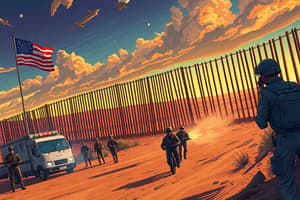Podcast
Questions and Answers
What critical impact did the Harrison Narcotics Tax Act of 1914 have on drug trafficking trends in the United States?
What critical impact did the Harrison Narcotics Tax Act of 1914 have on drug trafficking trends in the United States?
- It inadvertently spurred a rise in drug smuggling as opiates and cocaine became controlled substances. (correct)
- It led to a decrease in opiate and cocaine smuggling due to federal oversight.
- It eliminated drug smuggling by establishing strict regulations.
- It shifted the focus of smuggling operations to alcohol, overshadowing narcotics.
How did the Prohibition era (1920-1933) influence the landscape of drug smuggling in the United States?
How did the Prohibition era (1920-1933) influence the landscape of drug smuggling in the United States?
- It created a vacuum in the illegal market which was quickly filled by narcotics. (correct)
- It resulted in the dominance of marijuana as the primary smuggled substance.
- It led to dismantling of established smuggling networks.
- It decreased all forms of smuggling as resources were focused on alcohol.
Which of the following scenarios best illustrates the strategic shift in drug trafficking routes and dominance during the 1980s and 1990s?
Which of the following scenarios best illustrates the strategic shift in drug trafficking routes and dominance during the 1980s and 1990s?
- Colombian and Mexican cartels established control over key U.S. distribution hubs in cities such as Miami and Los Angeles. (correct)
- Government initiatives eliminated drug demand.
- European cartels began to control the distribution of heroin across the United States, utilizing established maritime routes.
- The increased local methamphetamine production reduced the reliance on foreign drug sources and smuggling.
What is the most significant change observed in drug smuggling trends from the 2000s to the present day compared to previous decades?
What is the most significant change observed in drug smuggling trends from the 2000s to the present day compared to previous decades?
What is the primary reason why drug smuggling continues to persist despite increased enforcement and stricter regulations?
What is the primary reason why drug smuggling continues to persist despite increased enforcement and stricter regulations?
Flashcards
Drug Smuggling
Drug Smuggling
Illegal transport/distribution of controlled substances across borders or within a country.
Harrison Narcotics Tax Act (1914)
Harrison Narcotics Tax Act (1914)
Act that initiated drug regulation in the United States.
Prohibition (1920-1933)
Prohibition (1920-1933)
Period when alcohol was illegal, leading to increased smuggling.
War on Drugs (1970s)
War on Drugs (1970s)
Signup and view all the flashcards
Colombian and Mexican Cartels
Colombian and Mexican Cartels
Signup and view all the flashcards
Study Notes
- Drug smuggling is the illegal transportation or distribution of controlled substances across borders or within a country.
- This includes movement of cocaine, heroin, marijuana, methamphetamine and other narcotics without authorization.
- It is done to evade law enforcement and customs regulations.
History of Drug Smuggling in the United States
- Early 1900s: Regulation began with the Harrison Narcotics Tax Act (1914), resulting in a rise of drug smuggling as opiates and cocaine were controlled.
- 1920s-1933: Alcohol smuggling led to the rise of heroin and cocaine smuggling during the Prohibition era.
- 1970s: The War on Drugs intensified enforcement, with Colombian and Mexican cartels bringing cocaine, heroin, and marijuana to the U.S.
- 1980s-1990s: Major Colombian and Mexican cartels dominated the U.S. drug trade, with Miami and Los Angeles as key smuggling hubs.
- 2000s-Present: There has been a surge in synthetic drugs like fentanyl and methamphetamine, and the U.S. is facing an opioid crisis.
Studying That Suits You
Use AI to generate personalized quizzes and flashcards to suit your learning preferences.




